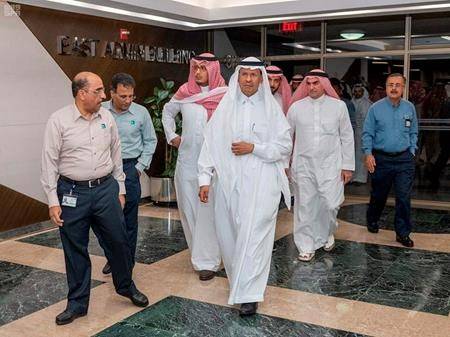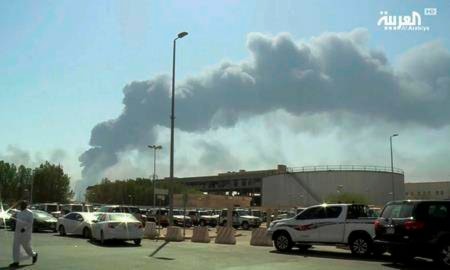Global energy prices spiked Monday by a percentage unseen since the 1991 Gulf War after a weekend attack on key oil facilities in Saudi Arabia caused the worst disruption to world supplies on record, further fueling heightened tensions between Iran and the U.S.
American officials released satellite images of the damage at the heart of the kingdom’s crucial Abqaiq oil processing plant and a key oil field, alleging the pattern of destruction suggested Saturday’s attack came from either Iraq or Iran — rather than Yemen, as claimed by Iranian-backed Houthi rebels there. A Saudi military spokesman later made the same accusation, alleging “Iranian weapons” had been used in the assault.
Iran rejected the allegations, with a government spokesman saying now there was “absolutely no chance” of a hoped-for meeting between Iranian President Hassan Rouhani and President Donald Trump at the U.N. General Assembly next week.
For his part, Trump sent mixed signals, saying his “locked and loaded” government waited for Saudi confirmation of Iran being behind the attack while later tweeting that the U.S. didn’t need Mideast oil, “but will help our Allies!”
The tensions have led to fears that action on any side could rapidly escalate a confrontation that’s been raging just below the surface in the wider Persian Gulf in recent months. There already have been mysterious attacks on oil tankers that Washington blames on Tehran, at least one suspected Israeli strike on Shiite forces in Iraq, and the downing of a U.S. military surveillance drone by Iran.
Those tensions have increased ever since Trump pulled the U.S. out of Iran’s 2015 agreement with world powers that curtailed its nuclear activities and the U.S. re-imposed sanctions on the country that sent its economy into freefall.
Benchmark Brent crude gained nearly 20% in the first moments of trading Monday before settling down to over 10% higher as trading continued. A barrel of Brent traded up $6.45 to $66.67.
That spike represented the biggest percentage value jump in Brent crude since the run-up to the 1991 Gulf War that saw a U.S.-led coalition expel Iraqi dictator Saddam Hussein’s forces from Kuwait.
U.S. benchmark West Texas crude was up around 10%. U.S. gasoline and heating oil similarly were up.
The attack halted production of 5.7 million barrels of crude a day, more than half of Saudi Arabia’s global daily exports and more than 5% of the world’s daily crude oil production. Most of that output goes to Asia.
At 5.7 million barrels of crude oil a day, the Saudi disruption would be the greatest on record for world markets, according to figures from the Paris-based International Energy Agency. It just edges out the 5.6 million-barrels-a-day disruption around the time of Iran’s 1979 Islamic Revolution, according to the IEA.
READ MORE: Iran to raise uranium enrichment beyond nuclear deal limits
Though the world’s overall energy demands in the past were smaller, the Saudi outage has sparked concern among analysts of prices pushing to $80 a barrel and beyond. Publicly traded airlines, whose major costs include jet fuel, suffered globally. That could in turn push up prices on everything from travel to a gallon of gas at the pump.
Saudi Arabia has pledged that its stockpiles would keep global markets supplied as it rushes to repair damage at the Abqaiq facility and its Khurais oil field. However, Saudi Aramco has not responded publicly to questions about its facilities.
The Associated Press
Like us on Facebook and follow us on Twitter

